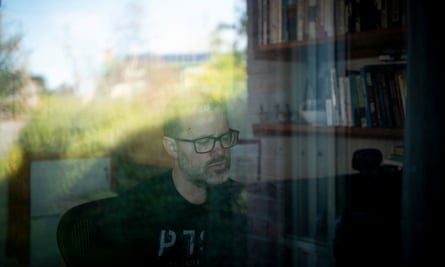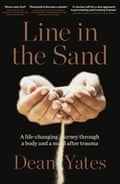Dean Yates was working in Reuters’ Jakarta newsroom on the night of 12 October 2002, when he took a call from a stringer in Bali. There had been a blast, the caller explained, with flaming cars and multiple victims.
“I can hear this screaming in the background,” Yates recalls 20 years later, “I can hear this noise.”
After filing a news alert, Yates caught the first plane from Jakarta, then a taxi to Kuta beach where the still-smoking bomb site had yet to be cordoned off. He went over for a closer look. “I could just feel this evil in the air,” Yates says, describing the moment he accidentally dislodged a piece of debris with his foot, revealing a bloodied hand.
“It was just shocking, to be standing at that scene of such devastation. But I had a job to do, so I was taking notes, I was constructing sentences in my head and on my notepad, ready to dictate through to our bureau in Jakarta.”
To those of us watching events like these unfold over TV, radio or newspapers, it’s difficult to forget when and where we were when the news broke. But for reporters such as Yates, working shoulder to shoulder with first responders to bring those stories to the world, such moments can be even harder to shake.
For much of Yates’ two decades overseas as a journalist and editor for Reuters, this “ringside seat” to history was part of the appeal. The professional trade-off, he says, was detachment. “My generation of journalists, we weren’t ever taught about feelings, acknowledging our emotions,” Yates explains over the phone, rugged up from his current home in northern Tasmania. “Detachment was considered a strength in those days, because you were seen as being that impartial observer – that was valued.
“I was just the perfect fit for that old-fashioned news agency journalist. But what it meant was that the detachment I was able to show as a journalist became entwined with who I was. So when the trauma started and the numbness started to emerge, I started to shut myself down – my emotions, my feelings.”
Yates left frontline reporting a decade ago, but the experience of covering the Bali bombing, and the Boxing Day tsunami two years later, stayed with him. Then there was the stint leading Reuters’ Baghdad bureau, when on 12 July 2007, his Iraqi colleagues Namir Noor-Eldeen and Saeed Chmagh were killed by a US Apache helicopter. The attack was later highlighted by Chelsea Manning and WikiLeaks in an infamous leaked video dubbed “Collateral Murder”.
For Yates, his perceived failure in preventing his staff’s death and then holding the American military to account, led to a tipping point that saw him diagnosed with PTSD and eventually admitted to Ward 17 at Melbourne’s Heidelberg Repatriation hospital in 2016.
It was in Ward 17 that Yates began writing what would eventually become a memoir, Line in the Sand, an unsparing account of a seven-year quest to understand his trauma and find a way to heal for himself, his wife – fellow ex-Reuters journalist Mary Binks – and their family.
Sharing a ward with veterans, police officers and the occasional chef or truck driver, Yates resolved to tell their stories alongside his own. “I found myself among this group of traumatised people, who were just like me, who found themselves adrift in the world.”
But as he began furiously journalling and researching, he underestimated the scope of what lay before him. “I thought I’d walk out of Ward 17 a new man – because again, I was sort of using all these tools of journalism, to work my way through what I thought were the problems.”
Yates was “knocked flat” when his psychiatrist explained he was only at the beginning of treatment. “She just looked at me and she said, ‘Yeah, I feel like I’ve been listening to a journalist reporting a story.’”

The clinician told Yates he was “intellectualising” his trauma, which prevented him from feeling and processing those emotions. It was something that would eventually take Yates several years and two return visits to Ward 17, to fully understand.
“It just wasn’t in my DNA to feel. So I was struggling, not only with the PTSD symptoms of numbness, but against that journalist who had gone into these places, reported on these events, who just went from one story to the next. There was never time to process any other stuff.”
As Line in the Sand reveals, unpacking that trauma meant forgetting about a “way to normal”, and finding peace with something new.
“There is no ‘aha’ moment – it’s not a straight line where you all of a sudden start to feel well,” he says.
“When you do work at healing from trauma, what you find is, actually, you can find a better life, you can find a new normal – a higher level of functioning, greater levels of empathy. And that can be found in the journey of recovery itself.”
As he releases his book into the world, Yates now worries about the current generation working in shrinking newsrooms where journalists are often overworked, under-supported and can be exposed to “horrendous” material.
His concern for this generation is about their exposure to “vicarious trauma”, which results from witnessing trauma or dealing with trauma survivors. It has typically been associated with first responders, such as medical professionals or emergency services, but is increasingly being recognised as something endured also by journalists. Even for those not out in the field, “the images that come through, the video, the photographs” can be deeply upsetting. “It comes in unfiltered, it’s coming in raw from wherever, and it’s often young journalists who have to verify this material and then edit it.”
This risk of trauma, he says, is still being understood by many news organisations – and not being taken seriously enough in many quarters. “I get journalists from around the world reaching out to me, asking how they should seek help.”
Vicarious trauma is increasingly being recognised as a serious hazard in workplaces, one which employers need to better protect staff from. In 2020, vicarious trauma made headlines when a Victorian lawyer was awarded $435,000 after working in a specialist sexual offences unit left her with PTSD and major depression due to exposure to high volumes of graphic evidence.

“The brain doesn’t differentiate between whether they are in their office or the field,” Yates says. “Ten minutes later, they might be sitting down to dinner with their family – but the trauma is just as real.”
For now, the publication of Line in the Sand means Yates has done something that might once have been unthinkable to that old-fashioned wire journalist: putting himself and his feelings at the heart of the story.
“Mary and I, we really wanted this book to be a true accounting of our life, and the trauma that we have gone through – and we wanted it to be absolutely honest.
“Not being part of a story has been thrown out the window,” he reflects, “In more ways than one.”

